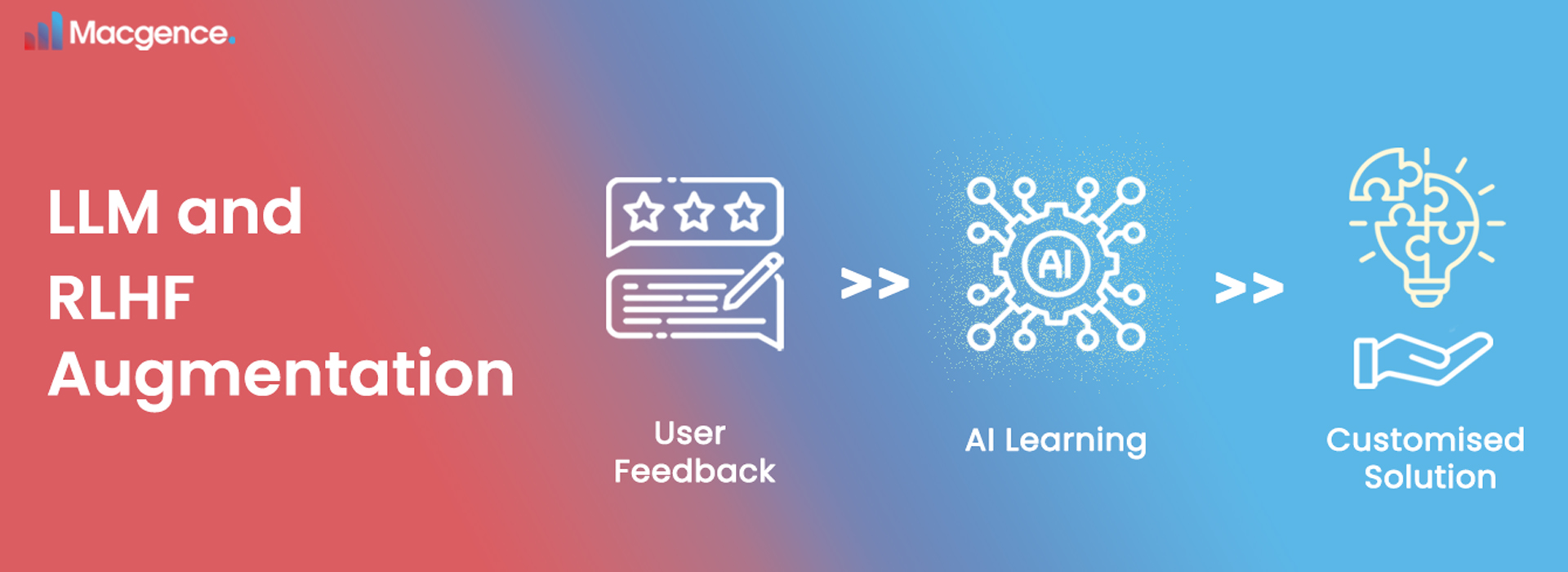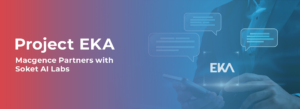A Full Overview to Understanding LLM and RLHF Augmentation
Language models and learning techniques have advanced in artificial intelligence (AI) in the last few years. They have completely changed how robots interpret and produce human language. The two main drivers of this progress are the augmentation of Reinforcement Learning from Human Feedback (RLHF) and large language models (LLM).
Read the blog below to explore these concepts in detail. Know their applications, implications, and the improvements they bring to AI development.
Understanding Large Language Models (LLM)

Large Language Models (LLMs) represent a revolutionary approach to processing natural language. These models are often made on deep learning architectures and fueled by vast datasets. Thus, they actively learn and generate text like human writing. OpenAI’s GPT-3 (Generative Pre-trained Transformer 3) and BERT (Bidirectional Encoder Representations from Transformers) are common examples of LLM. LLMs are Proficient in tasks such as sentiment analysis, content creation, and language translation. LLMs prove their efficacy across a diverse spectrum of AI applications.
Reinforcement Learning from Human Feedback (RLHF)

A powerful machine learning technique called reinforcement learning (RL) teaches a machine to make decisions by interacting with its surroundings. Additionally, RLHF goes one step further by introducing human feedback into the learning process. This augmentation involves using human testers’ comments along with conventional reinforcement learning to train AI models. RLHF also improves the model’s performance by using human insight, which makes the model more sensitive and adaptable to real-world situations.
Use case scenarios for LLM and RLHF Augmentation
LLM use cases

Because of their versatility, language models such as ChatGPT have found wide-ranging applications in several industries. The following are a few common use cases:
- Customer Support and Chatbots
Putting chatbots with AI to use for customer support, query management, information provision, and effective problem-solving.
- Content Generation
Developing marketing content, blogs, product descriptions, and articles at a large scale without affecting consistency and quality.
- Personalized Recommendations
Offering tailored suggestions for news, streaming media, and e-commerce platforms depending on user behavior and preferences.
- Language Translation
Promoting multilingual communication by providing translations that are precise and appropriate for the target context.
- Text Summarization
Extracting the most important information quickly and effectively by summarizing lengthy documents, articles, or reports.
- Virtual Assistants
Providing virtual assistants with task automation, information retrieval, scheduling, and reminders.
- Education and Training
Providing study materials, facilitating the creation of instructional content, and improving personalized learning experiences.
- Healthcare Support
Helping with patient inquiries, medical record keeping, and offering general health information.
- Code Generation and Assistance
Help developers in writing code snippets, providing documentation, and aiding in debugging processes.
- Legal and Compliance
Helping with contract analysis, compliance inspections, and the analysis of legal documents.
These applications show how language models such as ChatGPT are flexible and helpful in various industries, and how they may improve productivity, efficiency, and user experience.
Reinforcement Learning for Human Feedback (RLHF) Use Cases

Reinforcement Learning for Human Feedback (RLHF) can significantly enhance the mentioned use cases where direct human interaction and feedback are crucial for improving AI systems. Here are some scenarios where RLHF can be effectively utilized:
- Chatbots and Customer Support
RLHF can enhance chatbot interactions and ensure more precise and contextually relevant answers to client inquiries by learning from real-time human feedback.
- Content Generation and Refinement
RLHF uses human input to enhance the accuracy, relevance, and coherence of the output whenever human editing is necessary.
- Personalized Recommendations
Recommendation systems can be refined to deliver more precise and tailored choices by taking user behaviors and preferences into account.
- Virtual Assistants
Using information from human interaction to build more capable and helpful virtual assistants, thereby improving the user experience.
- Education and Training
Improving educational content by integrating feedback from students or educators. It also improves the relevance and effectiveness of generated materials.
- Code Generation and Assistance
Integrating user input to improve code generation and make sure that the resultant code is precise, effective, and in line with developer preferences.
In these situations, RLHF uses direct human interaction to support AI systems’ ongoing learning and development, making them more sensitive and adaptive to user preferences and demands.
The Partnership of LLM and RLHF Augmentation

One of the exciting developments in AI is the integration of LLM and RLHF techniques. This collaboration aims to address challenges related to biases, fine-tuning, and adaptability. LLMs, with their contextual understanding, can enjoy RLHF augmentation to refine their responses based on human input. This collaboration enhances the model’s ability to learn from specific feedback, improving its precision and relevance in diverse applications.
Applications Across Industries

The combined power of LLM and RLHF finds applications across various industries. In healthcare, these technologies can provide more accurate diagnosis and treatment recommendations. In finance, they can analyze market trends and optimize investment strategies. Further, customer service chatbots can provide more personalized and contextually relevant responses. The versatility of LLM and RLHF makes them invaluable tools for solving complex problems in diverse sectors.
Ethical Considerations and Responsible AI

The combination of LLM with RLHF may present ethical questions. However, this is common with any cutting-edge technology. Critical issues to overcome include biases in training data, ethical application of AI in decision-making, and model behavior transparency. Furthermore, responsible AI practices make sure that these technologies are used ethically to prevent unforeseen effects and build user confidence.
Conclusion

In summary, AI is advancing to new heights with the connection of large language models with reinforcement learning from human feedback. This partnership creates opportunities for more flexible and context-aware intelligent systems besides improving language understanding models’ capabilities. The journey toward intelligent machines has become an exciting and ever-evolving endeavor. Now, developers, researchers, and businesses continue to explore the potential of LLM and RLHF augmentation. Embracing these advancements responsibly will undoubtedly shape the future of AI. Furthermore, they will bring about positive transformations across industries and societies.
FAQs
Ans: – LLM and RLHF augmentation use large language models and human feedback to improve the AI system’s capabilities.
Ans: – LLM excels in language-related tasks like translation, while RLHF refines models using human input. Hence, they improve adaptability and performance in real-world scenarios.
Ans: – Yes, ethical concerns include biases in data and responsible AI practices to ensure fair and transparent model behavior.
Ans: – LLM and RLHF applications span diverse industries, including healthcare for accurate diagnoses and finance for optimized investment strategies.
You Might Like
February 28, 2025
Project EKA – Driving the Future of AI in India
Spread the loveArtificial Intelligence (AI) has long been heralded as the driving force behind global technological revolutions. But what happens when AI isn’t tailored to the needs of its diverse users? Project EKA is answering that question in India. This groundbreaking initiative aims to redefine the AI landscape, bridging the gap between India’s cultural, linguistic, […]
March 7, 2025
What is Data Annotation? And How Can It Help Build Better AI?
Spread the loveIntroduction In the world of digitalised artificial intelligence (AI) and machine learning (ML), data is the core base of innovation. However, raw data alone is not sufficient to train accurate AI models. That’s why data annotation comes forward to resolve this. It is a fundamental process that helps machines to understand and interpret […]
March 6, 2025
Vertical AI Agents: Redefining Business Efficiency and Innovation
Spread the loveThe pace of industry activity is being altered by the evolution of AI technology. Its most recent advancement represents yet another level in Vertical AI systems. This is a cross discipline form of AI strategy that aims to improve automation in decision making and task optimization by heuristically solving all encompassing problems within […]
March 5, 2025
Use of Insurance Data Annotation Services for AI/ML Models
Spread the loveThe integration of artificial intelligence (AI) and machine learning (ML) is rapidly transforming the insurance industry. In order to build reliable AI/ML models, however, thorough data annotation is necessary. Insurance data annotation is a key step in enabling automated systems to read complex insurance documents, identify fraud, and optimize claim processing. If you […]


 Previous Blog
Previous Blog







